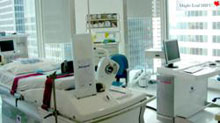
The year 2013 has gotten off to a solid start for device maker EDAP TMS with a steady stream of positive business and research news. The company has introduced its new Focal.One device for prostate cancer and is progressing in its quest for U.S. regulatory approval of its Ablatherm-HIFUsystem for localized prostate cancer.
Additionally, three new long-term studies demonstrate that treatments performed with the Ablatherm offer high survival rates for men with prostate cancer. The data is so compelling that German urologist Stefan Thüroff, MD, a principal investigator of one of the new studies, has called for focused ultrasound to be viewed as a definitive whole gland treatment.
“HIFU has remained investigational because the published research on the therapy has not yet reached sufficient maturity to be considered definitive,” he said. “The authors of this study concur that the collected data of 15-year outcomes may warrant the possible closing of the investigational phase of whole gland HIFU. The confidence this study provides in the ability to ablate prostate cancer may also encourage the use of focal therapy.”
Here’s a summary of the recent developments related to EDAP:
COMMERCIALIZATION ACTIVITIES
Focal.One System debuts in Europe
On March 14, 2013, EDAP premiered its Focal.One system at the European Association of Urology Annual Congress in Milan, Italy. The device combines three elements: 1) magnetic resonance imaging combined with real-time ultrasound, 2) HIFU focusing precision; and 3) immediate feedback on treatment efficacy utilizing Contrast-Enhanced Ultrasound Imaging.
EDAP’s Chief Executive Officer Marc Oczachowski described the Focal.One as “the first and only device specifically designed to fully answer the need from urologists for a non-invasive, robotic device that fully addresses the quality of life preservation concerns of prostate cancer patients who are increasingly better informed about treatment options.”
EDAP said it will seek CE marking for Focal.One during the second quarter of 2013 and begin commercialization in Europe thereafter. The company will also seek regulatory approvals in key global markets.
FDA application passes first review
EDAP broke new ground for the worldwide focused ultrasound industry in January 2013 by becoming the first manufacturer to seek U.S. Food and Drug Administration approval of a HIFU treatment for prostate cancer. The company’s FDA filing – a Premarket Approval (PMA) application – seeks clearance to market EDAP’s Ablatherm-HIFU system in the U.S. as a primary treatment for low risk, localized prostate cancer. The application has already passed administrative acceptance review and moved into the filing review phase. If the review is positive, the FDA will begin assessing the filing’s clinical data. In a recent video interview with the Focused Ultrasound Foundation, EDAP CEO Marc Oczachowski provided an overview of that data.
- VIEW VIDEO INTERVIEW WITH EDAP CEO
- VIEW EDAP VENDOR PRESENTATION from the 2012 International Focused Ultrasound Symposium
NEWLY PUBLISHED LONG-TERM RESEARCH
Publication of positive 14-year data
 Roman Ganzer, MD
Roman Ganzer, MDOn January 28, 2013, the British Journal of Urology (International) published online a 14-year retrospective studyof 538 prostate cancer patients treated with EDAP’s Ablatherm-HIFU system at the University of Regensburg in Germany. Five-year biochemical disease-free survival rates were 88% for low-risk patients and 83% for those at intermediate risk. Ten-year survival rates were 71% for low-risk patients and 63% for the intermediate-risk cohort.
The study was led by Roman Ganzer, MD, an associate professor of Urology at Regensburg. “Our results improve the understanding of the long-term cancer control of HIFU as a primary therapy for prostate cancer as well as the morbidity associated with the procedure,” he said. “The study solidifies the fact that HIFU is a safe and effective therapeutic option for patients with localized prostate cancer of low and intermediate risk profile. The morbidity experienced by patients was reasonable and, specifically, the rate of serious side effects such as recto-urethral fistulae is very low.”
15-year study shows high survival, salvage therapy unneeded
The study evaluated the cancer control and morbidity associated with Ablatherm-HIFU therapy in combination with transurethral resection of the prostate prior to treatment. The follow-up period ranged from 1.3 to 14 years, with a mean follow-up period of 5.3 years.In February 2013, theJournal of Urology published online a 15-year study involving 704 prostate cancer patients treated between 1995 and 2009 at the Munich-Harlaching Clinic in Munich, Germany. Most study participants (78.5%) had intermediate to high-risk disease.
Results showed high rates of both cancer-specific survival and freedom from salvage therapy. After treatment, patients had a cancer-specific survival rate of 99% and a metastasis-free survival rate of 95%. Overall survival rates did not differ across risk groups and were identical to regional population survival statistics. Salvage treatment-free rates were 98% for low-risk patients, 72% for those at intermediate-risk and 68% for men in the high-risk group.
Four-year study is largest in North America to date
 Maple Leaf HIFU Clinic was site of the Toronto study
Maple Leaf HIFU Clinic was site of the Toronto studyOn March 8, 2013, the British Journal of Urology(International) published online four-year data for more than 400 prostate cancer patients treated with the Ablatherm system at the Maple Leaf HIFU clinic in Toronto, Ontario, Canada. The Ablatherm has been an approved treatment method in Canada since 2003.
Patients were treated between May 2005 and December 2010 with one single HIFU session. Follow-ups occurred at regular intervals over a period of 6 to 48 months and included ing for prostate-specific antigen (PSA).
The study, which was conducted by seven noted urologists, showed that focused ultrasound as a primary treatment had promising four-year biochemically cancer free rates in low and intermediate risk prostate cancer patients. The study used two definitions of biochemical failure that have the ability to predict longer-term clinical failure.
Written by Ellen C., McKenna
